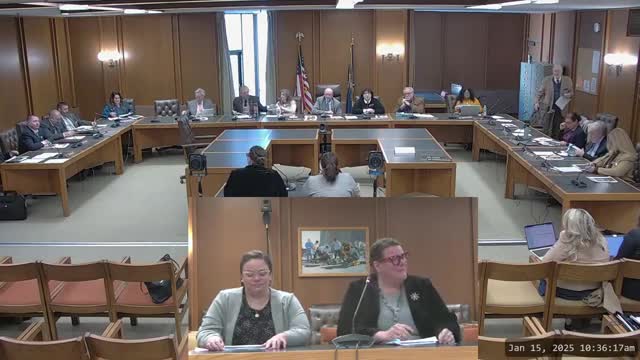Corrections commissioner outlines reentry, treatment programs, costs and facility planning
January 15, 2025 | Criminal Justice and Public Safety, House of Representatives, Committees , Legislative, New Hampshire
This article was created by AI summarizing key points discussed. AI makes mistakes, so for full details and context, please refer to the video of the full meeting. Please report any errors so we can fix them. Report an error »

Department of Corrections Commissioner Helen Hanks briefed the Criminal Justice and Public Safety Committee on prison population trends, treatment and reentry efforts, staffing levels and capital planning.
Hanks said the department continues to manage a population with a rising proportion of longer sentence structures, including a sizable share incarcerated for serious assaults. She reported about 45% of incarcerated people have an opioid use disorder (about 800 people), and that roughly 80% of those individuals have elected to participate in medication‑assisted treatment while incarcerated.
The department described expanded reentry supports: it received approval for a Centers for Medicare & Medicaid Services 1115 reentry waiver that allows two provider and two peer contacts and coverage for 30 days of discharge medications beginning 45 days prior to release for Medicaid‑eligible people. Hanks said the waiver and stronger connections to Medicaid post‑release will improve continuity of care and, she believes, reduce returns to custody.
Commissioner Hanks gave staffing and cost figures: average daily health care cost was cited at approximately $452 per person; the department reported a high overtime bill (about $27 million) and said correction officer vacancies have fallen from a prior high (about 189 vacancies) to nearer 162 as recruitment and compensation changes took effect. She described ongoing recruitment and retention efforts and volunteer ambassador programs for recruitment.
On recidivism and supervision, Hanks said the department monitors returns to custody and that parole‑related returns occupy a disproportionate share of beds; she reported roughly 300 people on the department’s caseload are in fugitive status. Hanks said the adult parole board’s revocations often stem from returning to criminal behavior, substance‑use relapses and noncompliance with treatment plans and that improving prerelease treatment connections is central to lowering returns to custody.
Corrections also described extensive education and reentry programming inside facilities: certified high‑school programs, career and technical education (including cosmetology and barbering programs), partnerships with community colleges under Second Chance Pell pilots, therapeutic housing units and case management teams that begin planning at intake and work toward parole and reentry goals.
Hanks described facility planning and capital funding: the first $10 million tranche for replacing the State Prison for Men is in contract and geological analysis is underway; the department expects to issue an RFP for an additional authorized $40 million.
Committee members asked about aging incarcerated populations and medical costs; Hanks said health‑care costs rise beginning in the 51+ age cohort and that the department can provide further breakdowns on age and life‑term sentences. The department offered to provide more detailed data on caseload ratios, average costs by age and the impact of educational and treatment programs on recidivism.
No formal committee votes were taken; the department offered facility tours and follow‑up data.
Hanks said the department continues to manage a population with a rising proportion of longer sentence structures, including a sizable share incarcerated for serious assaults. She reported about 45% of incarcerated people have an opioid use disorder (about 800 people), and that roughly 80% of those individuals have elected to participate in medication‑assisted treatment while incarcerated.
The department described expanded reentry supports: it received approval for a Centers for Medicare & Medicaid Services 1115 reentry waiver that allows two provider and two peer contacts and coverage for 30 days of discharge medications beginning 45 days prior to release for Medicaid‑eligible people. Hanks said the waiver and stronger connections to Medicaid post‑release will improve continuity of care and, she believes, reduce returns to custody.
Commissioner Hanks gave staffing and cost figures: average daily health care cost was cited at approximately $452 per person; the department reported a high overtime bill (about $27 million) and said correction officer vacancies have fallen from a prior high (about 189 vacancies) to nearer 162 as recruitment and compensation changes took effect. She described ongoing recruitment and retention efforts and volunteer ambassador programs for recruitment.
On recidivism and supervision, Hanks said the department monitors returns to custody and that parole‑related returns occupy a disproportionate share of beds; she reported roughly 300 people on the department’s caseload are in fugitive status. Hanks said the adult parole board’s revocations often stem from returning to criminal behavior, substance‑use relapses and noncompliance with treatment plans and that improving prerelease treatment connections is central to lowering returns to custody.
Corrections also described extensive education and reentry programming inside facilities: certified high‑school programs, career and technical education (including cosmetology and barbering programs), partnerships with community colleges under Second Chance Pell pilots, therapeutic housing units and case management teams that begin planning at intake and work toward parole and reentry goals.
Hanks described facility planning and capital funding: the first $10 million tranche for replacing the State Prison for Men is in contract and geological analysis is underway; the department expects to issue an RFP for an additional authorized $40 million.
Committee members asked about aging incarcerated populations and medical costs; Hanks said health‑care costs rise beginning in the 51+ age cohort and that the department can provide further breakdowns on age and life‑term sentences. The department offered to provide more detailed data on caseload ratios, average costs by age and the impact of educational and treatment programs on recidivism.
No formal committee votes were taken; the department offered facility tours and follow‑up data.
View full meeting
This article is based on a recent meeting—watch the full video and explore the complete transcript for deeper insights into the discussion.
View full meeting
